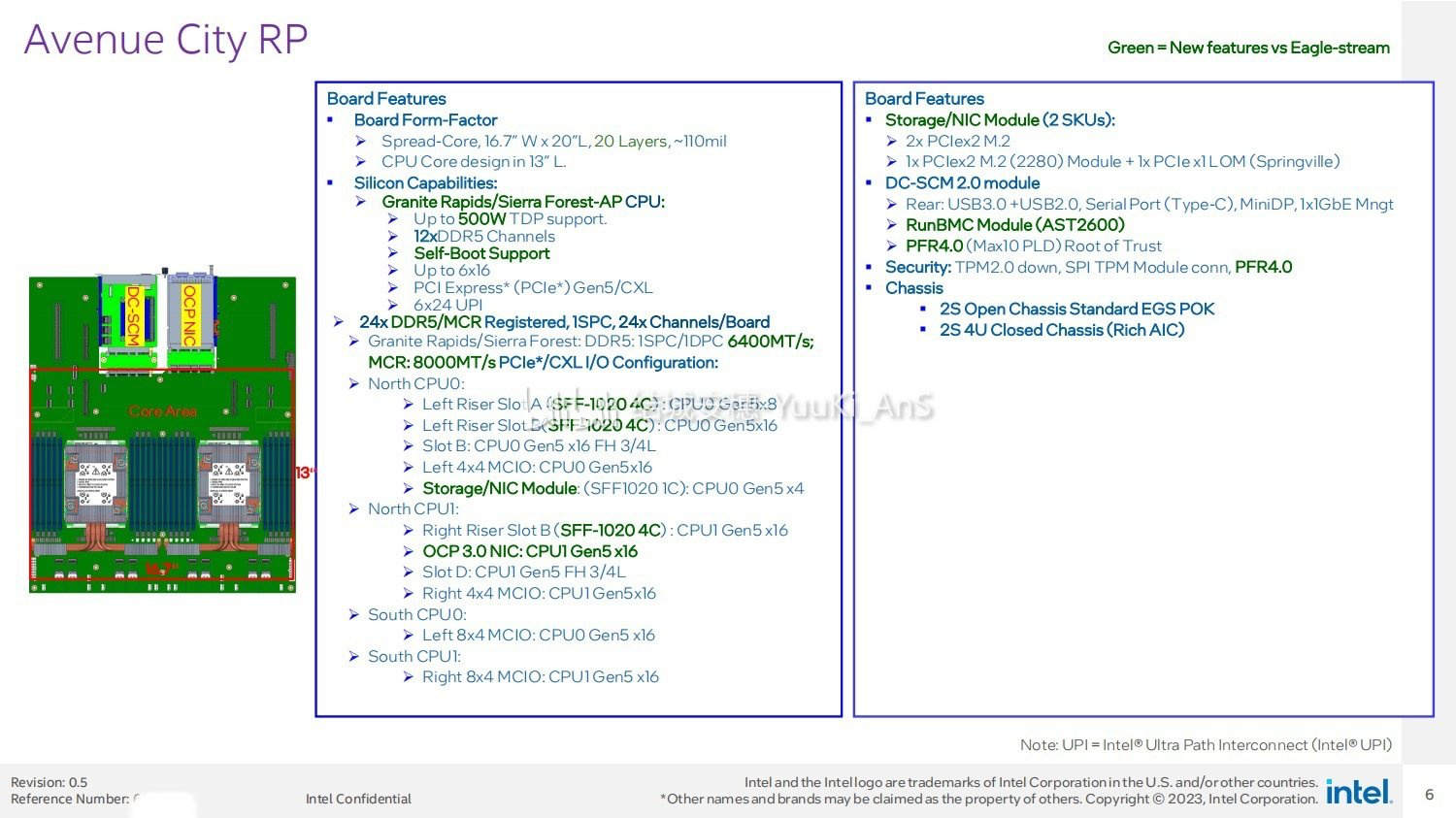Intel's Next-Gen LGA 7529 Xeon Platform to Deliver 500W per CPU, 12-Channel DDR5
Details about Intel's platform for Granite Rapids and Sierra Forest CPUs leak.
Intel's next-generation datacenter platform, supporting 'Granite Rapids' and 'Sierra Forest' processors will offer massive improvements in terms of memory bandwidth and input/output capabilities. That's according to a slide published by well-known hardware leaker YuuKi_AnS. But increased performance and throughput will come at a price: next-generation Xeon processors will have a thermal design power of up to 500W.
Intel's 6th Generation Xeon Scalable 'Granite Rapids' processors will increase high-performance core count compared to Sapphire Rapids and Emerald Rapids CPUs, whereas Intel's Xeon 'Sierra Forest' processors based on energy-efficient cores designed for high-density cloud datacenters will feature an even higher core count. These processors will use Intel's LGA7529 socket, and will have a TDP of up to 500W. So expect their peak power consumption under high loads to be significantly higher than previous-gen parts.

To feed those cores, the new CPUs will need a very sophisticated memory subsystem, and indeed the new CPUs will feature 12 DDR5 memory channels supporting both conventional DDR5-6400 memory modules (one DIMM per channel) as well as DDR5-8000 MCR DIMMs. When all channels are fully used, such a memory subsystem will provide up to 614.4 GB/s – 768 GB/s of bandwidth, a significant increase from Sapphire Rapids's 307.2 GB/s.
The new datacenter processors from Intel will also sport up to 96 PCIe Gen5 lanes, with the CXL protocol on top for high-performance accelerators/co-processors, storage devices, memory expanders, and other devices that use PCIe. Also, the CPUs will support 6x24 UPI links for CPU-to-CPU communications.
One of the platforms that Intel is prepping for its Granite Rapids and Sierra Forest processors is called 'Avenue City RP.' The motherboard will support key capabilities of the CPUs, as well as PFR 4.0 root of trust, a new-generation RunBMC AST26000 module, and OCP 3.0 network cards.
The slides do look like Intel's slides and are dated 2023. But since they come from an unofficial source, their contents should of course be taken with a grain of salt regardless of the leaker's track record.

Get Tom's Hardware's best news and in-depth reviews, straight to your inbox.

Anton Shilov is a contributing writer at Tom’s Hardware. Over the past couple of decades, he has covered everything from CPUs and GPUs to supercomputers and from modern process technologies and latest fab tools to high-tech industry trends.
-
USAFRet Reply
You shouldn't be running a microwave in your data center.derekullo said:Guess I won't be using Blender and the microwave at the same time. -
King_V Reply
Ha! Well I'm gonna run a data center in my microwave!USAFRet said:You shouldn't be running a microwave in your data center. -
bit_user Reply
I'm pretty sure you can still air-cool a 500 W CPU, in a server. If not, then many of their server customers simply won't run at the top power spec supported by the socket.vern72 said:I guess air cooling is out of the question.
Remember, the package will be huge, and the inside of these servers is like a wind tunnel. That makes the cooling problem a fair bit easier than if we were talking about a desktop CPU. -
bit_user Replyas well as DDR5-8000 MCR DIMMs.
These are very interesting (note: I didn't say good), as they increase the burst size to 128 bytes. That poses a compromise for CPUs that natively transact in 64-byte cachelines, and makes MCR slightly worse than standard DDR5-8000 would be. If you happened to want both consecutive cachelines, great. Otherwise, you still pay most of the price.
AST26000 module
Ugh. Why doesn't Intel just make their own BMC and get rid of ASpeed. Integrate it into the southbridge, and it would also cut the BOM and simplify server designs. -
Amdlova 500w on a multiple dies why not... people can cooler the 13900ks Xyz edition little dissipation area. The hottest cpu in have overclock is the pentium D 805 @ 4.3ghz draws at the wall 410w and have it done with a air cooler with a secondary fan at 5000 rpm.Reply -
dalek1234 ReplyAmdlova said:500w on a multiple dies why not... people can cooler the 13900ks Xyz edition little dissipation area. The hottest cpu in have overclock is the pentium D 805 @ 4.3ghz draws at the wall 410w and have it done with a air cooler with a secondary fan at 5000 rpm.
Let's roughly convert "At The Wall" to "At The CPU" so that we are comparing apples to apples: Pentium D 805 came out about 17 years ago. Back then, PSUs were about 60% efficient. This means that out of the 410w of "at the wall" power draw, 246 watts was being fed to the motherboard, while the rest was wasted as heat (mostly). You then have to account for the power draw of everything in your PC that isn't your CPU (Motherboard itself, Graphics Card, RAM, Fans, HDD, CD-ROM, etc). Out of those 246 Watts, your OC'ed Pentium would have used less then 200 Watts itself. Perhaps even considerably less. At stock of 2.66 GHz , that CPU is rated at only 95 Watt TDP. -
bit_user Reply
A peak load ?? That seems a little hard to believe.dalek1234 said:Pentium D 805 came out about 17 years ago. Back then, PSUs were about 60% efficient.
PSUs tend to be most efficient near peak load*. Efficiency drops the further away from it you get. Just make sure you're looking at the right number. Here's a contemporaneous source, in case there's any doubt about whether they same principle held back then:
https://www.anandtech.com/show/2259/4
In 2007, Anandtech's roundup of 400 - 450 W PSUs found peak efficiency ranging from 75% (outlier) to 85%:
Source: https://www.anandtech.com/show/2371/15
Their roundup of 750 - 900 W PSUs found peak efficiency ranging from 81% to 84%
Source: https://www.anandtech.com/show/2383/6So, to compute the PSU's output, you really need to ask @Amdlova what PSU was in use, or at least how many W it was rated for. Also, those articles include different efficiency data for 230 VAC, so that's another relevant parameter.
* This is one reason not to buy a PSU rated massively beyond the load you expect it to experience. Leaving some headroom is definitely wise.